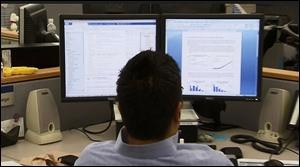By Pam Martens and Russ Martens: November 4, 2014
Economist and New York Times columnist Paul Krugman has been showering praise on the current administration for shrinking the budget deficit while scolding the press for failure to adequately report it: “where are the front-page news reports?” he writes on October 9.
The media has been duly pressed into action with Bloomberg News reporting a big headline today on its digital front page: “U.S. Deficit Decline to 2.8% of GDP Is Unprecedented Turn.”
But here’s a missing detail that carries a dark side: Over the past six years, $400 billion of deficit reduction has had nothing to do with Congress or the President and everything to do with those savvy traders sitting behind their Bloomberg terminals with their speed dials to Wall Street at the New York Fed. Like every other regional Federal Reserve Bank, the New York Fed, by law, hands over its surplus profits to the U.S. Treasury weekly. But as Table 7 at the attached Federal Reserve link shows, the bond holdings of the New York Fed dwarf those of any of the other 11 regional Fed banks; thus its interest income contributions to shrinking the deficit are also outsized.
According to the 2013 annual report of the System Open Market Account (SOMA), the New York Fed group that carries out monetary policy on instruction from the Federal Open Market Committee (FOMC) of the Federal Reserve, here’s what has happened since 2008:
“Primarily as a result of net income from the domestic SOMA portfolio, Federal Reserve remittances to the Treasury were almost $78 billion in 2013, high by historical standards but down from more than $88 billion in 2012. On a cumulative basis, remittances from 2008 to 2013 totaled $400 billion, about $250 billion more than the cumulative amount suggested by the average pre-crisis pace of about $25 billion per year, and a reflection of elevated portfolio income associated with policy measures taken to respond to the crisis and to strengthen the recovery…”
That $400 billion flowing into the U.S. Treasury that has helped shrink the budget deficit has carried a hefty price tag. The Federal Reserve’s balance sheet, through bond purchases known as QE1, QE2 and QE3, has ballooned from $869 billion in August 2007 to $4.45 trillion as of October 30, 2014. How the Federal Reserve will normalize that balance sheet to pre-crisis levels is uncharted waters and carries significant risks to the markets and the economy when unwinding begins. At present, the Fed’s holdings of U.S. Treasury notes and bonds and federal agency Mortgage Backed Securities (MBS) are being reinvested into like instruments. This means that the Fed’s balance sheet is not going to shrink anytime soon and its outsized payments to the U.S. Treasury will continue for an indefinite period.
The 2013 SOMA annual report acknowledges that fact, noting: “…based on current survey-based expectations for the paths of the portfolio and interest rates, as well as discussions by the FOMC in June 2013 suggesting that agency MBS sales during the normalization process are unlikely, SOMA net income is projected to remain higher than pre-crisis levels, on average, through 2025 in the current baseline projection and many alternative scenarios…”
Contributing to these outsized payments to the U.S. Treasury are some remarkable developments in concentrated positions within the Fed’s bond portfolio. With an announcement on September 21, 2011, the Federal Reserve embarked on “Operation Twist,” a program to buy longer-dated Treasury notes and bonds in order to put downward pressure on longer-term interest rates. Lower long-term interest rates allows families to refinance higher interest rate mortgages, ideally freeing up income for consumption to boost the lagging economy.
It also allows businesses to borrow at lower rates with the hoped for effect that they will be incentivized to build their business and hire more workers. Unfortunately, large corporations have used the low interest rate environment to borrow and buy back their own stock, boosting stock prices while the economy languishes.
Somewhere along the way, the Fed ended up owning 50 to 70 percent of entire issues of Treasury bonds with much higher coupons (fixed interest rates) than are available today. For example, it owns 70 percent, $17.8 billion, of the entire issue of Cusip 912810PX0, a Treasury bond maturing on May 15, 1938 with a fixed rate of 4.5 percent. Then there is this Treasury bond seniors would love to own today – unfortunately, 70 percent, $21.4 billion, is owned by the Fed, forcing its price dramatically higher and its yield much lower: it has a fixed interest rate of 8 percent, pays income semi-annually, and will make those payments through November 15, 2021 – another 7 years. (Check here for the Fed’s specific holdings of Treasury notes and bonds and the percent it owns of each issue.)
The Fed certainly succeeded in bringing down both short term and long term interest rates — the two-year Treasury Note is yielding a meager .51 percent this morning while the 10-year is paying 2.34 percent. The 30-year Treasury bond is yielding an unexciting 3.05 percent.
These yields have placed enormous stress on retirees who had counted on at least modest yields of 5 percent to supplement Social Security and/or pensions to make ends meet. After six years of Great Depression era interest rates, millions of seniors have had to dip into principal to pay bills to compensate for the reduced interest income coming from their Certificates of Deposit and Treasury notes and bonds. The reduced consumption from this large segment of citizens has produced a drag on economic growth.
In August, the Fed released a report showing that 52 percent of Americans would not be able to raise $400 in an emergency by tapping their checking, savings or borrowing on a credit card, which they would be able to pay off when the next statement arrived.


